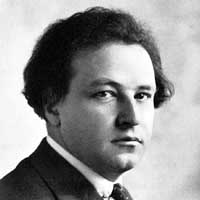Arthur Honegger Biography - A Very Quick Guide
Arthur Honegger (March 10, 1892 – November 27, 1955) was a Swiss composer, who lived a large part of his life in Paris. He was a member of Les Six. His most frequently performed work is probably the orchestral work Pacific 2311, which imitates the sound of a steam locomotive.
Born Arthur Oscar Honegger in Le Havre, France. He initially studied harmony and violin in Paris, and after a brief period in Zürich, returned there to study with Charles Widor and Vincent d'Indy. He continued to study through the 1910s, before writing the ballet Le dit des jeux du monde in 1918, generally considered to be his first characteristic work.
Between World War I and World War II, Honegger was very prolific, composing nine ballets and three operas, amongst other works. One of those operas, Jeanne d'Arc au bûcher (1935) is thought of as one of his finest works.
Honegger had always remained in touch with Switzerland, his root country, but with the outbreak of the war and the invasion of the Nazis, he found himself trapped in Paris. He joined the French Resistance, and was generally unaffected by the Nazis themselves, who allowed him to continue his work without too much interference, but it is said that he was greatly depressed by the war. Nonetheless, between its outbreak and his death, he wrote his last four symphonies (numbers two to five), which are quite frequently performed and recorded.
Arthur Honegger died on November 27, 1955 and was interred in the Cimetière Saint-Vincent in the Montmartre Quarter of Paris.
Although Honegger was a member of Les Six, his work does not typically share the playfulness and simplicity of the other members of that group. Far from reacting against the romanticism of Richard Wagner and Richard Strauss as the other members of Les Six did, Honegger's mature works show evidence of a distinct influence by it.
Born Arthur Oscar Honegger in Le Havre, France. He initially studied harmony and violin in Paris, and after a brief period in Zürich, returned there to study with Charles Widor and Vincent d'Indy. He continued to study through the 1910s, before writing the ballet Le dit des jeux du monde in 1918, generally considered to be his first characteristic work.
Between World War I and World War II, Honegger was very prolific, composing nine ballets and three operas, amongst other works. One of those operas, Jeanne d'Arc au bûcher (1935) is thought of as one of his finest works.
Honegger had always remained in touch with Switzerland, his root country, but with the outbreak of the war and the invasion of the Nazis, he found himself trapped in Paris. He joined the French Resistance, and was generally unaffected by the Nazis themselves, who allowed him to continue his work without too much interference, but it is said that he was greatly depressed by the war. Nonetheless, between its outbreak and his death, he wrote his last four symphonies (numbers two to five), which are quite frequently performed and recorded.
Arthur Honegger died on November 27, 1955 and was interred in the Cimetière Saint-Vincent in the Montmartre Quarter of Paris.
Although Honegger was a member of Les Six, his work does not typically share the playfulness and simplicity of the other members of that group. Far from reacting against the romanticism of Richard Wagner and Richard Strauss as the other members of Les Six did, Honegger's mature works show evidence of a distinct influence by it.
